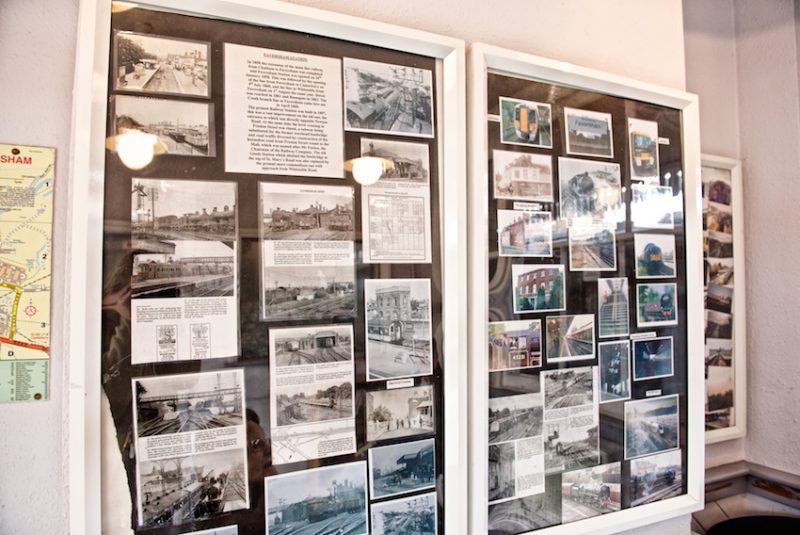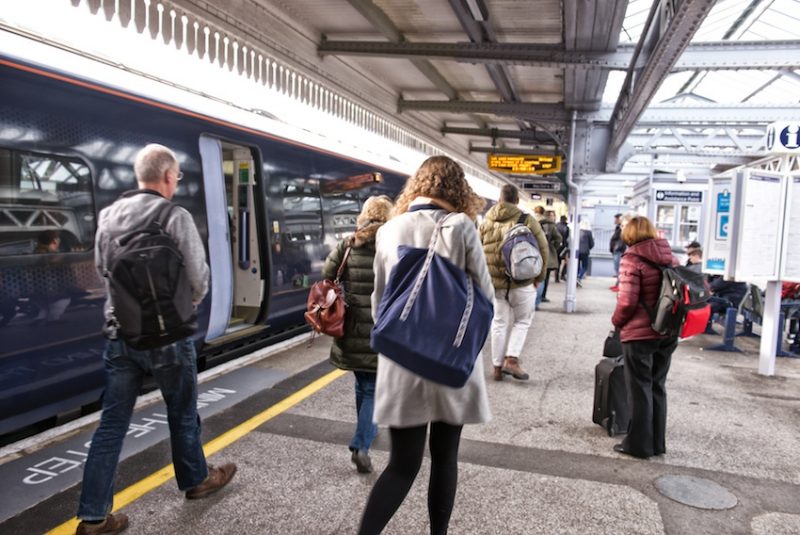What must it have been like the day the East Kent Railway opened from Strood to Faversham in January 1858? Exciting or frightening? Probably a bit of both. To celebrate this momentous event, the Lord Mayor of London held a dinner in the Assembly Rooms, Faversham.
There is a charming story recounted to me by the current inhabitant of Wreights House in the Mall: Whilst the railway was being constructed, the children of the Giraud family, who then lived at Wreights House, used to watch the workers from a specially constructed viewing platform in their garden. It was demolished c 1970. This demonstrates how novel the railway was at the time.

The exterior of Faversham Station
It took eight years to get an Act of Parliament to construct the single line track, despite the presence of three prominent local figures on the Board of the Railway Company: Lord Sondes, Lord Harris (of Belmont) and Mr C J Hilton (Mayor of Faversham in 1846). The scheme was controversial in a largely rural area devoid of major industry or large towns. Also there was serious competition and duplication of services with the already existing South Eastern Railway. They remained separate companies until 1923. ‘The story of how a single-tracked local line…of doubtful financial stability grew so rapidly as to secure the Continental Mail contract only four years later, and in so doing to shake the South Eastern to its very foundations, is one of the great dramas in British Railway History,’ wrote O S Nock, a notable railways authority, author of more than 140 books on railways.

A High Speed Train at Faversham Railway Station en route to London St Pancras
A fascinating twist in the story is the discovery by the railway workers digging the new cutting of what is now known as the Kings Field Hoard, an Anglo-Saxon site dating from the 6th and 7th centuries. ‘The magnificent collection of Kentish jewellery and other objects from Faversham now in the British Museum (some are also in the Ashmolean Museum, Oxford) attests the superiority in design and craftsmanship of such articles in the possession of the dwellers in East Kent over those in other parts of England at that time,’ writes Lord Harlech in his Ancient Monuments Vol II (1936).

The Victorian race to open railways linking all of East Kent makes for heady reading. The East Kent Railway became the London, Chatham and Dover Railway in 1859. Services were extended to Canterbury on 9 July 1860, to Whitstable a few weeks later, to London Victoria by Christmas that year. A goods-only link to Faversham Creek opened in April 1860, running along Standard Quay. In 1861 services reached Herne Bay, Dover and in 1863 Margate and Ramsgate.

The original fine railings on the platform
The advent of the railway led to a building boom in Faversham – Newton Road, St Mary’s Road, St John’s Road, Park Road and Orchard Place are amongst the many speculative housing streets constructed at that time.

The original station was directly opposite Newton Road and was similar to the surviving Sittingbourne Station. It was rebuilt in 1897 in yellow stock brick with red rubbed heads to windows and doorways. The interior is particularly fine, and the painted, curving wooden-panelled ticket office, sadly no longer in use, is very handsome.

The handsome interior of Faversham Station
A quirky detail is the Art Deco arrow pointing to the door to what is now a coffee shop at the start of the long slope down from the ticket barriers.

An Art Deco flourish at Faversham Station

The unusual long sloping walkway at Faversham Station
At one time the Station Master lived in Delbridge House, the fine late 18th century house at the Preston Street end of the station complex.
Before the underpass was built there was a level crossing just by Delbridge House.

Level crossing in Preston Street in 1896
As early as 1884 there was a plan for a loop road underpass but this would have involved the demolition of Wreights House. Happily the owner resisted, and about 10 years later the current loop road was constructed. It was named Forbes Road, after the railway company’s chairman. It was at this juncture that the station was rebuilt to extend the station to four tracks. The original 1858 brick railway ‘shed’ survives but is now derelict largely due to its inaccessibility, although a listed building.

Fascinating assemblage of old postcards and information about the station in the waiting room
The early years of the 20th century were halcyon days for the railway in East Kent. It is shocking to discover that trains from Victoria were at least five minutes faster then than they are today! The Cliftonville left Victoria at 9.10am for Margate, ‘slipping coaches at Faversham’. The 51-mile journey from London to Faversham took 68 minutes, the same time as today’s High Speed Rail. ‘We dash through Faversham station, past the crowds waiting the arrival of the ‘slip’ portion,’’ writes one Ronald A Senior-White in Railway and Travel Monthly in December 1913.


21st century railway passengers
Lord Harris (son of the Lord Harris who was chairman in 1858) was a stockbroker in London and he used to thank the driver punctiliously every morning at the conclusion of his journey to London.

In 1959 the line was electrified and the platforms were lengthened. Unlike so many other stations in East Kent, Faversham still conjures up the atmosphere of the 19th century heyday of the coming of the railways. The station buildings were listed in 1987.
For more detailed information: www.kentrail.org.uk/Faversham.htm
Text: Amicia. Photographs: Lisa